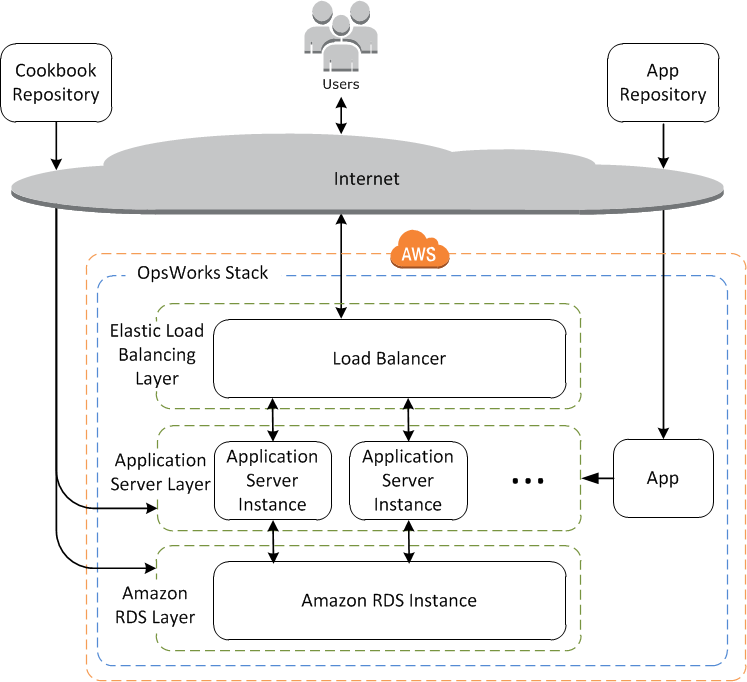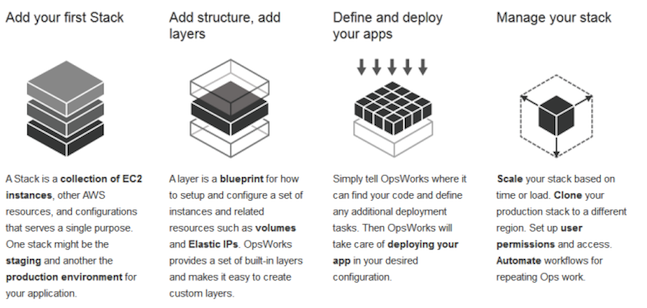Have you ever had to manually configure VM deployments? Then you know how time-consuming and tedious it can get. Imagine an automatic service that handles infrastructure deployment for different apps, regardless of the resource requirements. How cool would that be? Well, welcome to the world of AWS OpsWorks.
This cloud-computing platform from Amazon Web Services is an automation solution that comes with a ton of flexibility to give you complete control over your applications and their underlying infrastructure. With OpsWorks, you can manage the entire lifecycle of your application, from resource provisioning to access control and everything in between. Hence, you can develop, configure, and deploy applications of any complexity, as this platform is independent of any particular architecture.
For cloud administrators and developers, OpsWorks makes it easier than ever to configure and deploy tasks across distributed applications, with the resource configuration of your choice. The best part about this platform is that it comes at no additional charge, so you only pay for those resources that you use.
[tg_youtube video_id=”TPc4zdFg12M”]
Before going into how OpsWorks works, let’s see why you should choose OpsWorks in the first place.
Why AWS OpsWorks?
If you’re already using providers like Heroku, you may wonder what’s the big deal with OpsWorks.
One of the drawbacks of many providers is that you’re limited to a few common patterns and standard packages offered by these services. Such predefined patterns greatly restrict the architecture and functionality of your application. Often, you’ll have to pick the architecture that best works for your application, rather than being guided by what the application would need.
With OpsWorks though, you have greater flexibility, as you can customize the servers as well as the layers or services that your application needs. Also, it offers better control over EC2 instances and architectures, and other AWS services. Further, it provides greater automation and a more robust set of tools for managing your application. In fact, a defining feature of OpsWorks is that it makes it easy for you to manage applications, regardless of their complexity and scale. In addition, it automates much of the deployment tasks such as support, rollback, patch management, and more. These unique aspects make OpsWorks a popular cloud platform for creating any type of application.
Now that we know why OpsWorks is better than many other cloud platforms, let’s delve a little into its basic architecture to get a better understanding of its operations.
Components of AWS OpsWorks
OpsWorks has the following components:
- Stack – At the highest level, stack is a container for AWS resources such as EC2 and RDS database instances. It can have custom configurations and any number of applications running on it.
- Layer – A layer represents a set of services that work together to achieve a common purpose. A typical application can have many layers, each doing a specific task. These layers can represent any one of the following Amazon services: Amazon RDS, Amazon EC2, and elastic load balancing.
- Instances – An instance can be broadly defined as the basic configuration of a single computing resource, such as an Amazon EC2 instance. The configuration is typically restricted to operating system and size, while other settings such as Elastic IP addresses are defined by the instance’s layers. OpsWorks supports the following instances:
- Time-based – These instances are run by AWS on a daily and weekly schedule. It even adjusts the number of instances to accommodate your usage patterns.
- 24/7 – These instances are started manually, and they run until you stop them.
- Load-based – These instances are started by AWS OpsWorks, and they run until the instances reach a specific load metric such as CPU utilization, after which OpsWorks stops them. This type of instance is available only for Linux-based stacks.
- Applications – Applications are your code that can come from a repository or S3 bucket. You can choose to combine and configure more than one application together.
- Chef – Although Chef is not really a component of OpsWorks, it’s worth talking about here because it is a tool for automating server configuration. This tool contains code templates called “recipes” that help to configure each layer, and “cookbooks” that contain one or more recipes. You can use pre-existing Chef recipes for doing tasks like installing packages, running scripts, restarting servers, authorizing users, and more. Also, OpsWorks five lifecycle events – setup, configure, deploy, undeploy, and shutdown -run on a specified set of recipes that are pre-scheduled.

These are the different components of AWS OpsWorks, and we’ll next see how they come together to give you the desired functionality.
Working of AWS OpsWorks
OpsWorks begins by setting up the stack, where system configurations, load-balancing options, server, and database settings are defined. Next, it organizes layers, which are nothing but subsystems such as web and database servers. Also, layers contain different instances and the resources needed for an application. You can use Chef to customize stacks and layers with custom code or by using pre-built templates called cookbooks. You can choose to create any number of stacks and layers. The default computing limit is 20 stacks containing 20 layers each.
Once stacks and layers are ready, OpsWorks takes application code from the location of your choice, and runs it on the different instances. It also supports AWS Identity and Access Management, so you can better manage user access and authorization.
OpsWorks gives you many features to monitor your stack, and troubleshoot when needed. CloudWatch metrics for Linux stacks and Windows stacks, CloudTrail logs, and Chef logs can help you to get to the bottom of an issue and troubleshoot it.

AWS OpsWorks also supports a Command Line Interface (CLI) and SDKs for many languages, to give you wider choices to create different applications.
AWS OpsWorks is a powerful platform that allows you to manage applications with complete control over every functionality and aspect. Along with other offerings from Amazon such as AWS CloudFormation and AWS Elastic Beanstalk, and commercial solutions from AWS partners, creating and deploying applications have become easier than ever before.
Photo credit: Amazon and allthingsdistributed



